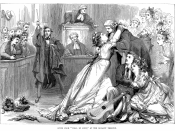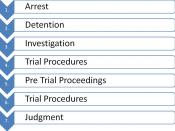Procedures of Criminal Trial (American)
One of the most vaguely understood events in the United States is the modern criminal trial. Most people have a faint knowledge of the goings-on of criminal proceedings, mainly due to what is seen on television, but the person who knows the real course of a trial is rare. However, there is nothing mysterious about the events that determine criminal guilt. Trials are carefully orchestrated, following procedures that have been laid in legal concrete over the years, and generally follow the same basic format across the United States.
Criminal law is distinguishable from civil law in the aspect that criminal acts are officially considered to injure not only individuals, but society as a whole. This is the reason why criminal cases are described as state v. offender. The state, as the injured party, is taking the defendant to court. The purpose of a criminal trial is to determine if the offender is legally guilty of the crime, but this does not necessarily mean that the person in question committed the crime.
As opposed to factual guilt (the person 'did it'), legal guilt merely means that a jury of the defendant's peers is convinced without reasonable doubt. As can be seen, this leaves room for possible discrepancies.
Before a trial can proceed, certain events must take place. The first is the arraignment of the defendant, which can happen anytime between arrest and a logical, non-specific time before the trial itself. Arraignment consists of the court reading to the defendant the substance of the charge, and calls on the subject to enter a plea within a given time.
The defendant may consult with and be advised by an attorney on what plea to offer the court. He may plead guilty or no contest (nolo contendere), in which...



Get oriented with ruse used to indict or defend a suspect
It has cleared most of the doubts how the prosecutor and the defence teams will try to discredit each other to substantiate their evidence or to get the benefit of doubt.
2 out of 2 people found this comment useful.